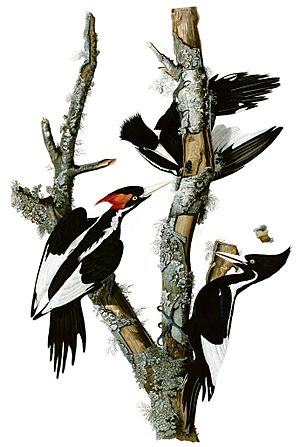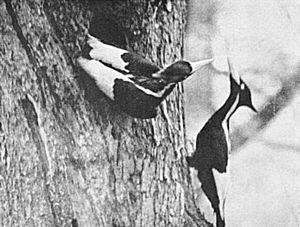Ivory-billed woodpecker facts for kids
Quick facts for kids Ivory-billed woodpecker |
|
|---|---|
 |
|
| A hand-coloured photo of a male from 1935 | |
| Conservation status | |
| Scientific classification | |
| Genus: |
Campephilus
|
| Species: |
principalis
|
| Subspecies | |
|
Campephilus p. principalis |
|
| Synonyms | |
|
Picus principalis Linnaeus, 1758 |
|
The ivory-billed woodpecker (Campephilus principalis) is one of the biggest woodpeckers on Earth. It can be about 20 inches (51 cm) long, and its wings can spread up to 30 inches (76 cm) wide!
This amazing bird used to live in the old, untouched forests of the Southeastern United States and Cuba. Sadly, because people cut down too many trees (which is called habitat destruction), and also because of some hunting, there are very few of these birds left. We're not even sure if any are still alive today, though some people say they have seen them recently. Most forests now are not big enough or healthy enough to support a group of ivory-billed woodpeckers.
The International Union for the Conservation of Nature says the ivory-billed woodpecker is critically endangered, which means it's very close to disappearing forever. They even say it might already be extinct. The American Birding Association also lists it as "definitely or probably extinct."
In 2004, some people reported seeing an ivory-billed woodpecker in Arkansas. A team from the Cornell Lab of Ornithology looked into these reports. They searched for five years, but they couldn't find clear proof, like a photo or video, to confirm the sightings.
People have offered rewards to help find these birds. In 2006, someone offered $10,000 for information about a nest or feeding spot. In 2008, The Nature Conservancy offered $50,000 to anyone who could lead a biologist to a living ivory-billed woodpecker.
Even with reports from places like Arkansas, Florida, and Louisiana since the 1940s, there's still no clear proof that the ivory-billed woodpecker is still around. No one has undisputed photos, videos, or DNA samples from feathers or droppings. To help protect any birds that might still be alive, groups are buying land and restoring their natural habitat in areas where the birds might still exist.
Where They Live and What They Eat

Ivory-billed woodpeckers like to live in thick swampy forests and pine forests. These forests need lots of dead and decaying trees. Before the American Civil War, huge areas of the Southern United States were covered in these old, big forests. This was perfect for the ivory-billed woodpecker.
At that time, these birds lived from east Texas to North Carolina, and from southern Illinois all the way down to Florida and Cuba. But after the Civil War, the timber industry cut down millions of acres of trees in the South. This left only small, separate patches of forest that were suitable for the birds.
The ivory-billed woodpecker mostly eats the larvae (young) of wood-boring beetles. But they also eat seeds, fruit, and other insects. They use their huge white bill to hammer, wedge, and peel bark off dead trees to find these insects.
These birds need a lot of space to find enough food for themselves and their young. Each pair needs about 25 km2 (9.7 sq mi) of forest. This means they naturally live far apart from each other, even when their populations are healthy. Another common bird, the pileated woodpecker, might also compete with them for food.
Reproduction and Life Cycle
It's believed that ivory-billed woodpeckers stay with the same partner for their whole lives. Pairs are also known to travel together. These paired birds mate every year between January and May.
Both parents work together to dig out a nest in a dead or partly dead tree before their young are born. They usually lay two to five eggs, which hatch in about 3 to 5 weeks. Both parents take turns sitting on the eggs to keep them warm. The male usually incubates from late afternoon until early morning, while the female looks for food. Then they switch roles for the rest of the day.
They feed their chicks for several months. Young birds learn to fly about 7 to 8 weeks after they hatch. Their parents continue to feed them for another two months after that. The family usually separates in late fall or early winter. Scientists think these birds might live as long as 30 years.
Images for kids
See also
 In Spanish: Carpintero picomarfil para niños
In Spanish: Carpintero picomarfil para niños










